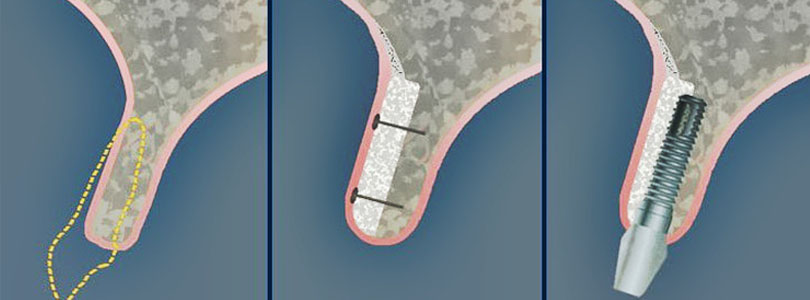
Sinus elevation
Bone grafting is necessary when there is not enough quality and quantity of bone material surrounding either the implant area or that of the surviving roots. Bone reduction occurs naturally over time and is the reason why implants should be placed very soon after extraction.
What causes bone loss?
Whenever a tooth is lost or extracted a considerable amount of the bone that once surrounded the remaining root portion may disappear. This loss can be particularly rapid during the first few months and is described as ‘bone resorption’. Although the rate and amount of bone resorption is highly variable between individuals, it will always occur to some extent, unless specific care is taken to reduce its effects. Sometimes, the simplest measure to minimise bone loss after an extraction is to place the implant immediately (if there is no infection) or within the first few months.
What is Bio-Oss?
Bio-Oss is a safe, effective bone graft material. Under other electron microscope, Bio-Oss looks very similar to human bone and is highly successful in helping new bone to form. Bio-Oss acts as a framework onto which bone forming cells and blood vessels travel along the Bio-Oss framework, healthy new bone is formed and the defect is repaired. It is prepared from specially processed bovine sources. Every batch of Bio-Oss goes through highly controlled processing and sterilization procedures which remove all impurities. At the end of these procedure, every batch of Bio-Oss must pass rigorous sterility and purity tests, assuring total safety of the materials.
Sinus elevation
This procedure involves elevating the sinus membrane and placing the Bio Oss bone graft onto the sinus floor, allowing implants to be placed in the back part of the upper jaw. Premature loss of upper back teeth results in a down growth of the maxillary sinus floor. So that implants of adequate length may be placed, the floor of the sinus is elevated and supported by bone graft material. This procedure has been performed successfully for over two decades now and is considered an accepted and predictable method of bone grafting.
Duration: 20 – 30 min/side
Expect
- Swelling (should settle down within 5 – 7 days)
- Bruising (should settle down within 5 – 9 days)
- Tenderness (should settle down within 30 days)
Must avoid:
- Blowing your nose (for 1 week)
- Sneezing (for 1 week)
- Eating milk products (1 week)
What to do after surgery:
- Take a calcium tablet after the surgery: helps to aid healing (provided at the clinic for free)
- Use an icepack for 1 day after the surgery: helps reduce swelling (provided at the clinic for free)
- Take antibiotics after the suregry: protect against infection (Dalacin C is provided at the clinic for free – follow your dentist’s prescription. If you are allergic to Penicilin, please make sure you mention this at the clinic)
- Can take painkillers: helps reduce pain (Cataflam is provided at the clinic for free, if necessary take 1 every 4 hours with food, maximum 4 daily. Discontinue after 4 days.)
After care:
- Brush your gums very gently with a soft toothbrush 2 – 3 times daily in a circular motion
- Use mouthwash 3 times daily (provided at the clinic for free)
- Arnica (herb) can help speed up healing and reduce swelling & bruising
